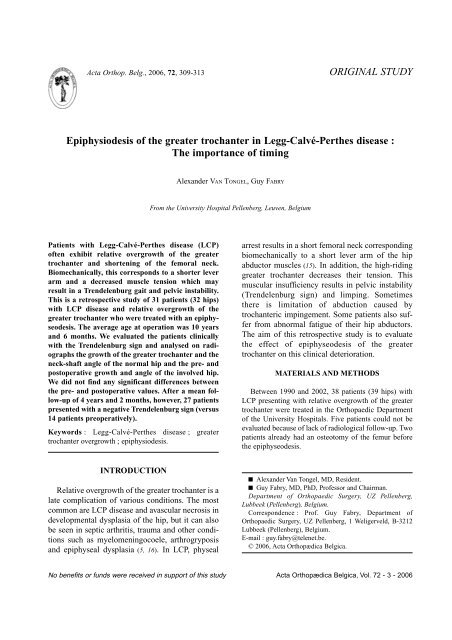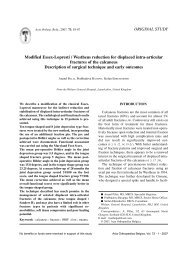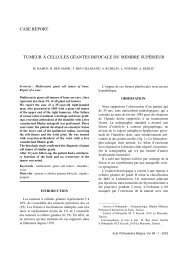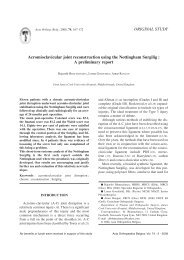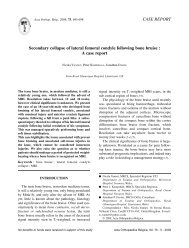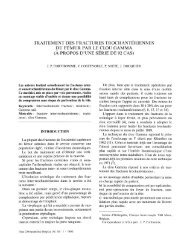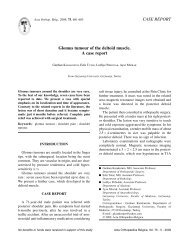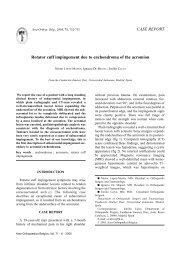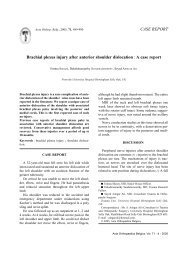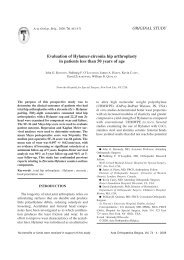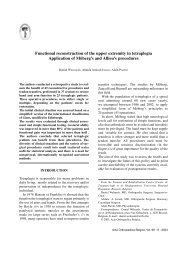Epiphysiodesis of the greater trochanter in Legg-Calvé-Perthes ...
Epiphysiodesis of the greater trochanter in Legg-Calvé-Perthes ...
Epiphysiodesis of the greater trochanter in Legg-Calvé-Perthes ...
- No tags were found...
Create successful ePaper yourself
Turn your PDF publications into a flip-book with our unique Google optimized e-Paper software.
Acta Orthop. Belg., 2006, 72, 309-313ORIGINAL STUDY<strong>Epiphysiodesis</strong> <strong>of</strong> <strong>the</strong> <strong>greater</strong> <strong>trochanter</strong> <strong>in</strong> <strong>Legg</strong>-Calvé-Per<strong>the</strong>s disease :The importance <strong>of</strong> tim<strong>in</strong>gAlexander VAN TONGEL, Guy FABRYFrom <strong>the</strong> University Hospital Pellenberg, Leuven, BelgiumPatients with <strong>Legg</strong>-Calvé-Per<strong>the</strong>s disease (LCP)<strong>of</strong>ten exhibit relative overgrowth <strong>of</strong> <strong>the</strong> <strong>greater</strong><strong>trochanter</strong> and shorten<strong>in</strong>g <strong>of</strong> <strong>the</strong> femoral neck.Biomechanically, this corresponds to a shorter leverarm and a decreased muscle tension which mayresult <strong>in</strong> a Trendelenburg gait and pelvic <strong>in</strong>stability.This is a retrospective study <strong>of</strong> 31 patients (32 hips)with LCP disease and relative overgrowth <strong>of</strong> <strong>the</strong><strong>greater</strong> <strong>trochanter</strong> who were treated with an epiphyseodesis.The average age at operation was 10 yearsand 6 months. We evaluated <strong>the</strong> patients cl<strong>in</strong>icallywith <strong>the</strong> Trendelenburg sign and analysed on radiographs<strong>the</strong> growth <strong>of</strong> <strong>the</strong> <strong>greater</strong> <strong>trochanter</strong> and <strong>the</strong>neck-shaft angle <strong>of</strong> <strong>the</strong> normal hip and <strong>the</strong> pre- andpostoperative growth and angle <strong>of</strong> <strong>the</strong> <strong>in</strong>volved hip.We did not f<strong>in</strong>d any significant differences between<strong>the</strong> pre- and postoperative values. After a mean follow-up<strong>of</strong> 4 years and 2 months, however, 27 patientspresented with a negative Trendelenburg sign (versus14 patients preoperatively).Keywords : <strong>Legg</strong>-Calvé-Per<strong>the</strong>s disease ; <strong>greater</strong><strong>trochanter</strong> overgrowth ; epiphysiodesis.arrest results <strong>in</strong> a short femoral neck correspond<strong>in</strong>gbiomechanically to a short lever arm <strong>of</strong> <strong>the</strong> hipabductor muscles (15). In addition, <strong>the</strong> high-rid<strong>in</strong>g<strong>greater</strong> <strong>trochanter</strong> decreases <strong>the</strong>ir tension. Thismuscular <strong>in</strong>sufficiency results <strong>in</strong> pelvic <strong>in</strong>stability(Trendelenburg sign) and limp<strong>in</strong>g. Sometimes<strong>the</strong>re is limitation <strong>of</strong> abduction caused by<strong>trochanter</strong>ic imp<strong>in</strong>gement. Some patients also sufferfrom abnormal fatigue <strong>of</strong> <strong>the</strong>ir hip abductors.The aim <strong>of</strong> this retrospective study is to evaluate<strong>the</strong> effect <strong>of</strong> epiphyseodesis <strong>of</strong> <strong>the</strong> <strong>greater</strong><strong>trochanter</strong> on this cl<strong>in</strong>ical deterioration.MATERIALS AND METHODSBetween 1990 and 2002, 38 patients (39 hips) withLCP present<strong>in</strong>g with relative overgrowth <strong>of</strong> <strong>the</strong> <strong>greater</strong><strong>trochanter</strong> were treated <strong>in</strong> <strong>the</strong> Orthopaedic Department<strong>of</strong> <strong>the</strong> University Hospitals. Five patients could not beevaluated because <strong>of</strong> lack <strong>of</strong> radiological follow-up. Twopatients already had an osteotomy <strong>of</strong> <strong>the</strong> femur before<strong>the</strong> epiphyseodesis.INTRODUCTIONRelative overgrowth <strong>of</strong> <strong>the</strong> <strong>greater</strong> <strong>trochanter</strong> is alate complication <strong>of</strong> various conditions. The mostcommon are LCP disease and avascular necrosis <strong>in</strong>developmental dysplasia <strong>of</strong> <strong>the</strong> hip, but it can alsobe seen <strong>in</strong> septic arthritis, trauma and o<strong>the</strong>r conditionssuch as myelomen<strong>in</strong>gocoele, arthrogryposisand epiphyseal dysplasia (5, 16). In LCP, physeal■ Alexander Van Tongel, MD, Resident.■ Guy Fabry, MD, PhD, Pr<strong>of</strong>essor and Chairman.Department <strong>of</strong> Orthopaedic Surgery, UZ Pellenberg,Lubbeek (Pellenberg), Belgium.Correspondence : Pr<strong>of</strong>. Guy Fabry, Department <strong>of</strong>Orthopaedic Surgery, UZ Pellenberg, 1 Weligerveld, B-3212Lubbeek (Pellenberg), Belgium.E-mail : guy.fabry@telenet.be.© 2006, Acta Orthopædica Belgica.No benefits or funds were received <strong>in</strong> support <strong>of</strong> this study Acta Orthopædica Belgica, Vol. 72 - 3 - 2006
310 A. VAN TONGEL, G. FABRYFig. 2. — The NSA (neck-shaft angle) on <strong>the</strong> AP radiograph(8).Fig. 1. — The ATD (articulo-<strong>trochanter</strong>ic distance) is measuredas <strong>the</strong> distance <strong>in</strong> millimeters between two parallel l<strong>in</strong>esperpendicular to <strong>the</strong> axis <strong>of</strong> <strong>the</strong> shaft <strong>of</strong> <strong>the</strong> femur, one at <strong>the</strong>level <strong>of</strong> <strong>the</strong> tip <strong>of</strong> <strong>the</strong> <strong>greater</strong> <strong>trochanter</strong> and <strong>the</strong> o<strong>the</strong>r at <strong>the</strong>highest part <strong>of</strong> <strong>the</strong> ossified femoral head. The distance isrecorded as positive if <strong>the</strong> tip <strong>of</strong> <strong>the</strong> <strong>greater</strong> <strong>trochanter</strong> is caudalto <strong>the</strong> highest part <strong>of</strong> <strong>the</strong> femoral head and negative if <strong>the</strong>tip <strong>of</strong> <strong>the</strong> <strong>trochanter</strong> is proximal to <strong>the</strong> femoral head (8).The medical and radiological records from more thanone year before <strong>the</strong> operation were available <strong>in</strong>26 patients. Five patients were seen only one monthbefore operation. All 31 patients (32 hips) had postoperativecl<strong>in</strong>ical and radiological follow-up. There were7 girls and 24 boys. The left hip was affected <strong>in</strong>23 patients, <strong>the</strong> right hip <strong>in</strong> 7 patients and <strong>in</strong> one patientboth hips were <strong>in</strong>volved.The mean age at operation was 10 years and6 months, rang<strong>in</strong>g from 7 years and 11 months to12 years and 1 month. The mean follow-up time was4 years and 2 months (range : 7 months to 7 years and9 months).Indications for epiphyseodesis were a positiveTrendelenburg sign with overgrowth <strong>of</strong> <strong>the</strong> <strong>greater</strong><strong>trochanter</strong> or an <strong>in</strong>crease <strong>in</strong> relative overgrowth dur<strong>in</strong>gfollow-up.In 24 cases, a shelf acetabuloplasty was performed at<strong>the</strong> same time. In 5 cases, only an epiphyseodesis <strong>of</strong> <strong>the</strong><strong>greater</strong> <strong>trochanter</strong> was done, and on two occasions <strong>the</strong>epiphyseodesis was done a few months after a shelfacetabuloplasty.The Phemister technique for epiphyseodesis asdescribed by Langenskiöld and Salenius (12) wasused (21).The growth <strong>of</strong> <strong>the</strong> <strong>greater</strong> <strong>trochanter</strong> was evaluated,us<strong>in</strong>g <strong>the</strong> articulo-<strong>trochanter</strong>ic distance (ATD) (fig 1).The neck-shaft angle (NSA) was also measured (fig 2).Both measurements were done pre- and postoperatively,both on <strong>the</strong> affected hip and <strong>the</strong> normal hip (8, 17). Thecl<strong>in</strong>ical Trendelenburg sign was evaluated (2, 6) and comparedwith <strong>the</strong> ATD and <strong>the</strong> NSA <strong>of</strong> <strong>the</strong> <strong>in</strong>volved hip.The results were analysed us<strong>in</strong>g statistical analysiss<strong>of</strong>tware (SAS) (18). The age dependence <strong>of</strong> <strong>the</strong> ATD andNSA and <strong>the</strong> difference between boys en girls andbetween different procedures were analysed us<strong>in</strong>gregression analysis. The differences between pre-andpostoperative observations were evaluated by analysis <strong>of</strong>covariance. The evaluation <strong>of</strong> <strong>the</strong> cl<strong>in</strong>ical situation wascalculated with <strong>the</strong> SIGN testRESULTSFirst <strong>the</strong> NSA and ATD <strong>of</strong> <strong>the</strong> normal hip wereevaluated. The average distance and angle for everypatient dur<strong>in</strong>g one year (for example from <strong>the</strong> 7 th to<strong>the</strong> 8 th birthday) were calculated. Regression analysisproduced curves, show<strong>in</strong>g <strong>the</strong> evolution <strong>of</strong>ATD and NSA <strong>in</strong> <strong>the</strong> normal hips accord<strong>in</strong>g to ageActa Orthopædica Belgica, Vol. 72 - 3 - 2006
EPIPHYSIODESIS OF THE GREATER TROCHANTER 311Fig. 3. — Evolution <strong>of</strong> <strong>the</strong> ATD <strong>of</strong> <strong>the</strong> normal hip <strong>in</strong> patientswith LCP. Age <strong>in</strong>terval : 1 : 4-5 ; 2 : 5-6 ; 3 : 6-7 ; ……. ; 12 :15-16 years (Le values <strong>in</strong> millimetres).Fig. 5. — Evolution <strong>of</strong> <strong>the</strong> ATD <strong>of</strong> <strong>the</strong> <strong>in</strong>volved hip <strong>in</strong> patientswith LCP pre-operatively.Fig. 4. — Evolution <strong>of</strong> <strong>the</strong> NSA <strong>of</strong> <strong>the</strong> normal hip <strong>in</strong> patientswith LCP (H values <strong>in</strong> degrees).Fig. 6. — Evolution <strong>of</strong> <strong>the</strong> ATD <strong>of</strong> <strong>the</strong> <strong>in</strong>volved hip <strong>in</strong> patientswith LCP post-operatively.<strong>in</strong>tervals (figs 3 and 4). The same measurementswere performed for <strong>the</strong> <strong>in</strong>volved hip pre- and postoperatively(figs 5, 6, 7, 8). Figure 5 clearly showsa decrease <strong>in</strong> ATD over <strong>the</strong> years preoperatively.Postoperatively, however, <strong>the</strong> decrease cont<strong>in</strong>ues.There was no significant difference between bothresults. Also concern<strong>in</strong>g <strong>the</strong> NSA no significantdifference was found. There was no difference <strong>in</strong>results accord<strong>in</strong>g to age or gender. There was nodifference between <strong>the</strong> three types <strong>of</strong> procedures.At <strong>the</strong> time <strong>of</strong> operation 18 patients had a positiveTrendelenburg sign. After follow-up only tworema<strong>in</strong>ed positive (p = 0.001). From <strong>the</strong> 14 patientswith a negative Trendelenburg sign pre-operatively,11 rema<strong>in</strong>ed negative and 3 became positive (p =0.029). No ATD value could be def<strong>in</strong>ed where <strong>the</strong>Trendelenburg sign becomes positive. In <strong>the</strong>patients who became positive postoperatively noclear change <strong>in</strong> <strong>the</strong> ATD and NSA was seen. Theyall had a shelf-acetabuloplasty at <strong>the</strong> same time.Acta Orthopædica Belgica, Vol. 72 - 3 - 2006
312 A. VAN TONGEL, G. FABRYFig. 7. — Evolution <strong>of</strong> <strong>the</strong> NSA <strong>of</strong> <strong>the</strong> <strong>in</strong>volved hip <strong>in</strong> patientswith LCP pre-operatively.Fig. 8. — Evolution <strong>of</strong> <strong>the</strong> NSA <strong>of</strong> <strong>the</strong> <strong>in</strong>volved hip <strong>in</strong> patientswith LCP post-operatively.DISCUSSIONThe three major problems that may occur <strong>in</strong> LCPare : 1) a femoral length discrepancy that progresseswith growth because <strong>of</strong> damage to <strong>the</strong> proximalcapital physis, 2) coxa magna and loss <strong>of</strong> sphericitywith subluxation and secondary coxarthrosis and3) coxa brevis and relative overgrowth <strong>of</strong> <strong>the</strong><strong>greater</strong> <strong>trochanter</strong>.Several o<strong>the</strong>r methods <strong>of</strong> surgical treatment forhigh stand<strong>in</strong>g <strong>greater</strong> <strong>trochanter</strong> have been reported,such as lateral displacement osteotomy (14), distaltransfer <strong>of</strong> <strong>the</strong> <strong>greater</strong> <strong>trochanter</strong> (16, 22), femoralneck leng<strong>the</strong>n<strong>in</strong>g osteotomy (7), <strong>greater</strong> <strong>trochanter</strong>icadvancement (4) or comb<strong>in</strong>ations <strong>the</strong>re<strong>of</strong> (9, 14, 17).However , <strong>the</strong> least <strong>in</strong>vasive operation is epiphyseodesis,which aims at obta<strong>in</strong><strong>in</strong>g a growth arrest (5,14).This procedure was already proposed <strong>in</strong> 1940 (3)and <strong>the</strong> first study was done by Langenskiöld andSalenius (12). They showed <strong>in</strong> studies us<strong>in</strong>g tetracycl<strong>in</strong>efluorescence that epiphyseodesis <strong>of</strong> <strong>the</strong><strong>trochanter</strong>ic growth plate can be expected to preventonly about half <strong>of</strong> <strong>trochanter</strong>ic overgrowth,because <strong>the</strong> rema<strong>in</strong><strong>in</strong>g half results from appositionalbone growth <strong>in</strong> <strong>the</strong> cephalic portion <strong>of</strong> <strong>the</strong><strong>trochanter</strong>.Most authors reported that <strong>the</strong> operation shouldbe done before <strong>the</strong> age <strong>of</strong> 8 years (5, 11, 12, 14, 17).Katz (10) stated that <strong>the</strong> growth <strong>in</strong> length <strong>of</strong> <strong>the</strong>femoral neck was most pronounced after <strong>the</strong> age <strong>of</strong>9 years. The distance between <strong>the</strong> <strong>greater</strong><strong>trochanter</strong> and <strong>the</strong> top <strong>of</strong> <strong>the</strong> femur does not changemarkedly after 8 years <strong>of</strong> age <strong>in</strong> a normal hip (8).The relative overgrowth is caused by <strong>the</strong> growtharrest <strong>of</strong> <strong>the</strong> capital epiphysis (1). Moreover,patients with LCP <strong>of</strong>ten present with a retardation<strong>of</strong> skeletal maturation (19). It was <strong>the</strong>refore supposedthat <strong>the</strong> operation could also have its effect atan older age.In this study <strong>the</strong> average age at operation was10 years and 6 months. We did not see a significantdifference <strong>in</strong> <strong>the</strong> monthly change <strong>of</strong> <strong>the</strong> distancebefore and after <strong>the</strong> operation. Probably <strong>the</strong> <strong>in</strong>dicationfor operation was made too late.But <strong>the</strong> question might be raised why so manypatients did well after <strong>the</strong> operation. The hip abductors<strong>in</strong> adults have to work at full capacity to preventpelvic <strong>in</strong>stability (20). Maybe when <strong>the</strong> childgrows, <strong>the</strong> muscles adapt to this specific situation<strong>of</strong> relative overgrowth. We did not f<strong>in</strong>d any literaturedescrib<strong>in</strong>g <strong>the</strong> maximum capacity <strong>of</strong> <strong>the</strong> muscles<strong>in</strong> childhood and whe<strong>the</strong>r children also musthave a full capacity <strong>of</strong> muscle strength.In our <strong>in</strong>vestigation <strong>the</strong>re were no patients withan articulo-<strong>trochanter</strong>ic distance that became negative.O<strong>the</strong>r authors state that patients with an ATD<strong>of</strong> less than 5 mm almost always have a positiveActa Orthopædica Belgica, Vol. 72 - 3 - 2006
EPIPHYSIODESIS OF THE GREATER TROCHANTER 313Trendelenburg sign (13), but <strong>the</strong>re was no follow-upuntil adulthood. Probably an articulo-<strong>trochanter</strong>icdistance <strong>of</strong> 5 mm or less is too difficult to properlyadapt to, mak<strong>in</strong>g an operative treatment necessary.It was already po<strong>in</strong>ted out by Gage and Cary (5)that epiphyseodesis <strong>of</strong> <strong>the</strong> <strong>greater</strong> <strong>trochanter</strong> doesnot affect <strong>the</strong> evolution <strong>of</strong> <strong>the</strong> neck-shaft angle,which was confirmed <strong>in</strong> this study.CONCLUSIONEpiphyseodesis <strong>of</strong> <strong>the</strong> <strong>greater</strong> <strong>trochanter</strong> is asmall operation to prevent relative <strong>trochanter</strong> overgrowth.It should be done before <strong>the</strong> age <strong>of</strong> 8, andonly to prevent <strong>the</strong> articulo-<strong>trochanter</strong>ic distance tobecome negative. After <strong>the</strong> age <strong>of</strong> 8 years, <strong>the</strong>epiphyseodesis can no longer reduce <strong>the</strong> relativeovergrowth. Only when <strong>the</strong> articulo-<strong>trochanter</strong>icdistance is negative, can an operative treatment tocorrect overgrowth be <strong>in</strong>dicated. O<strong>the</strong>rwise wepropose to wait until adulthood because a number<strong>of</strong> cl<strong>in</strong>ical problems will resolve dur<strong>in</strong>g maturation.REFERENCES1. Barnes J. Premature epiphyseal closure <strong>in</strong> Per<strong>the</strong>s’disease. J Bone Jo<strong>in</strong>t Surg 1980 ; 62-B : 432-437.2. Calvé J, Galland M, De Cagny R. Pathogenesis <strong>of</strong> <strong>the</strong>limp due to coxalgia. J Bone Jo<strong>in</strong>t Surg 1939 ; 21 : 12-25.3. Compere E, Garrison M, Fahey J. Deformities <strong>of</strong> <strong>the</strong>femur result<strong>in</strong>g from arrestment <strong>of</strong> growth <strong>of</strong> <strong>the</strong> capitaland <strong>greater</strong> <strong>trochanter</strong>ic epiphyses. J Bone Jo<strong>in</strong>t Surg1940 ; 22 : 909-915.4. Fernbach S, Poznanski A, Kelikian A et al. Greater<strong>trochanter</strong>ic overgrowth : development and surgical treatment.Radiology 1985 ; 154 : 661-664.5. Gage JR, Cary JM. The effects <strong>of</strong> <strong>trochanter</strong>ic epiphyseodesison growth <strong>of</strong> <strong>the</strong> proximal end <strong>of</strong> <strong>the</strong> femurfollow<strong>in</strong>g necrosis <strong>of</strong> <strong>the</strong> capital femoral epiphysis. J BoneJo<strong>in</strong>t Surg 1980 ; 62-A : 785-794.6. Hardcastle P, Nade S. The significance <strong>of</strong> <strong>the</strong> Trendelenburgtest. J Bone Jo<strong>in</strong>t Surg 1985 ; 67-B : 741-747.7. Hasler C, Morscher E. Femoral neck leng<strong>the</strong>n<strong>in</strong>gosteotomy after growth disturbance <strong>of</strong> <strong>the</strong> proximal femur.J Pediatr Orthop 1999 ; 8-B : 271-275.8. Heuck F, Bast B. Radiologische Skizzen und Tabellen.Peripheres Skelett New York 1994 : 62-64, 98-100, GeorgThieme Verlag Stuttgart.9. Joseph B, Sr<strong>in</strong>ivas G, Thomas R. Management <strong>of</strong>Per<strong>the</strong>s disease <strong>of</strong> late onset <strong>in</strong> Sou<strong>the</strong>rn India. J BoneJo<strong>in</strong>t Surg 1996 ; 78-B : 625-630.10. Katz J. Late modell<strong>in</strong>g changes <strong>in</strong> <strong>Legg</strong>-Calvé-Per<strong>the</strong>sDisease (LCPD) with cont<strong>in</strong>u<strong>in</strong>g growth to maturity. Cl<strong>in</strong>Orthop 1980 ; 150 : 115-125.11. Langenskiöld A. Changes <strong>in</strong> <strong>the</strong> capital growth plate and<strong>the</strong> proximal femoral metaphysis <strong>in</strong> <strong>Legg</strong>-Calvé-Per<strong>the</strong>sdisease. Cl<strong>in</strong> Orthop 1980 ; 150 : 110-114.12. Langenskiöld A, Salenius P. Epiphyseodesis <strong>of</strong> <strong>the</strong><strong>greater</strong> <strong>trochanter</strong>. Acta Orthop Scand 1967 ; 38 : 199-219.13. Leitch J, Paterson D, Foster B. Growth disturbance <strong>in</strong><strong>Legg</strong>-Calvé- Per<strong>the</strong>s disease and <strong>the</strong> consequences <strong>of</strong> surgicaltreatment. Cl<strong>in</strong> Orthop 1991 ; 262 : 178-184.14. Litt R, Albassir A, Willems S, Debry R. Coxa vara.Croissance isolée du grand <strong>trochanter</strong>. Prévention –Traitement. Acta Orthop Belg 1990 ; 56 : 301-306.15. Maquet P. Importance de la position du grand <strong>trochanter</strong>.Acta Orthop Belg 1990 ; 56 : 307-322.16. Mart<strong>in</strong>ez I, Garrido F, Molto D, Luch L. Distal transfer<strong>of</strong> <strong>the</strong> <strong>greater</strong> <strong>trochanter</strong> <strong>in</strong> acquired coxa vara. Cl<strong>in</strong>ical andradiographic results. J Pediatr Orthop 2003 ; 12-B : 38-43.17. Matan A, Stevens P, Smith J, Santora S. Comb<strong>in</strong>ation<strong>trochanter</strong>ic arrest and <strong>in</strong>ter<strong>trochanter</strong>ic osteotomy forPer<strong>the</strong>s’ Disease. J Pediatr Orthop 1996 ; 16 : 10-14.18. SAS. Institute Inc. 1988 ; Cory, NC, USA.19. Shapiro F. <strong>Legg</strong>-Calvé-Per<strong>the</strong>s disease : A study <strong>of</strong> lowerextremity length discrepancies and skeletal maturation.Acta Orthop Scand 1982 ; 53 : 437-444.20. Su<strong>the</strong>rland D. Gait Disorders <strong>in</strong> Childhood andAdolescence. Occult limps. Williams and Wilk<strong>in</strong>s,Baltimore/London. 1984, pp 57-60.21. Tachdjian MO. Atlas <strong>of</strong> Pediatric Surgery. W.B.Saunders, Philadelphia/ London. 1994, I, pp 588-595.22. Takata K, Maniwa S, Ochi M. Surgical treatment <strong>of</strong>high-stand<strong>in</strong>g <strong>greater</strong> <strong>trochanter</strong>. Acta Orthop TraumaSurg 1999 ; 119 : 461-463.Acta Orthopædica Belgica, Vol. 72 - 3 - 2006


